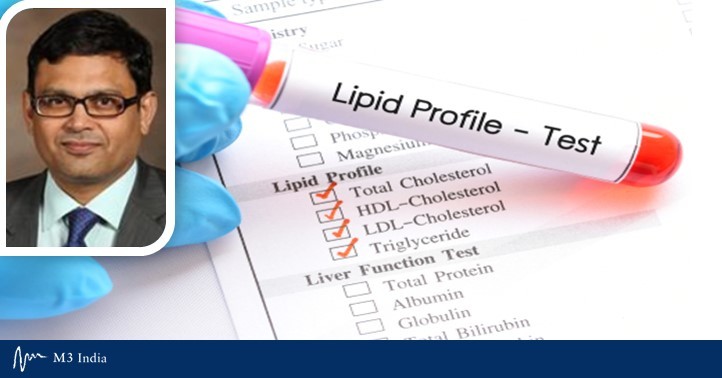What the new AHA / ACC Lipid Guidelines mean for India– Praise, reproach and puzzlement-Prof. Sundeep Mishra
M3 India Newsdesk Nov 17, 2018
In the recently concluded American Heart Association (AHA) annual scientific session which was held in Chicago, November 10-12, 2018 new cholesterol-lowering guidelines were presented and simultaneously published online in the “Circulation” and “Journal of American College of Cardiology” journal.

Based on recent controlled trials, other data and expert consensus the guidelines represent the next step from the previous 2013 guidelines which were perhaps a bit unbalanced and rather severely criticized. This guideline returns back to defining lipid targets for most secondary prevention and some primary prevention strategies and reducing the focus only on high dose statins, reaffirms the benefit of CV risk calculation and life-style management before initiating lipid pharmacotherapy and brings in new concepts and treatments like “clinical-patient risk discussion,” pharmacotherapy beyond statins; ezetimibe and PCSK-9 but also cost-effectiveness of therapy and use of coronary calcium to refine the risk assessment. However, some flaws still persist.
Top Praiseworthy items
- They suggest a personalized patient-based approach to lipid management strategy with > 10 streams with individual management strategy for each of them.
| Primary prevention | Secondary prevention | |
| Age 0-10 y | ASCVD Not very high risk, Age ≤ 75 y | |
| Age 20-39 y | ASCVD Not very high risk, Age > 75 y | |
| Age 40-75y |
Low Risk (<5%) Borderline Risk (5-<7.5%) Intermediate Risk (≥7.5 - <20%) High Risk (≥20%) |
Very high risk ASCVD |
| Age > 75 y | ||
| LDL≥ 190 mg% | ||
| Diabetes Mellitus |
- They reflect at least a partial return to identifying lipid-lowering goals at least in the majority of patients requiring secondary prevention i.e. with established atherosclerotic cardiovascular disease (ASCVD). The goal identified is LDL-C ≤ 70 mg%. In primary hypercholesterolemia, this goal is identified as ≥ 100mg%.
- Provide a management strategy (diagnosis and treatment) even for children and young adults (<20 years) as also emphasizing lifetime risk assessment in 20-39 year age group.
- They mark a shift towards lowering the use of high-dose statins blindly in the majority of patients, which was the main limitation of 2013 guidelines and raised the suspicion of an industry-bias.
- On the other hand, these new guidelines now emphasize clinician –patient “risk discussion” in the majority of patients requiring primary prevention before initiating statin therapy. This perhaps is the single most important advance in patient management in the new guideline and should not only improve the patient management it would help create a better doctor-patient bond.
- For the first time, it recommends the use of non-statin drugs in those patients where secondary prevention (or even primary prevention s/a primary hypercholesterolemia) goals cannot be met.
- Ezetimibe is the second line drug where goals cannot be met with just statins and PCSK-9 inhibitors can be further added to statins and ezetimibe treatment if required. On the other hand, niacin or CETP inhibitors are not recommended.
- This guideline emphasizes the use of heart-healthy lifestyles before using any drug therapy.
- This guideline emphasizes the use of life-time risk calculation using risk calculators to guide the statin therapy in primary prevention.
- For the first time (in perhaps history of Western medicine) the guideline brings forth the issue of cost, thus preferring ezetimibe (good cost value) over PCSK9 (low-cost value).
- The value of coronary artery calcium (CAC) in estimating the future risk of CAD has been underlined. If CAC score is 0, statin therapy may be avoided, if, between 1-99, it may be considered if some other high-risk features are present, on the other hand, a score of ≥ 100 warrants a physician-patient discussion for statin therapy.
- A careful monitoring of statin therapy (adherence and % response) is advisable initially at 1-3 month and later after 3-12 months.
Reproach
- One of the main limitations of earlier (2013) guideline was that the data applies to only White Caucasian populations while ignoring the vast swathe of populations from Asia, Africa and even parts of America. This new guideline still fails to address this concern.
- Likewise, the tools or risk assessment are focused on white Western populations and no attempt to adapt them to a vast majority of world population is done.
- It is an all American document with practically no authors from outside America and therefore its applicability to non-American world is doubtful.
- Guidelines are still formed keeping re-imbursement in mind.
- Guidelines still seem to be focused only on LDL values and practically ignore the condition of low HDL and high triglyceride dyslipidemia.
- Some authors have academic relations with Industry which could have been avoided.
Puzzlement
- There are too many management groups (actually 12) which may not only be easy to remember but may be too confusing for an average clinician.
- Many recommendations are vague and may result in varying interpretations.
- All in all these new guidelines do represent a significant advance in the area of dyslipidemia offering a “patient based approach” to manage dyslipidemia and does overcome several limitations of the previous 2013 lipid guidelines particularly “lack of goals” and recommendation of a blind use of “high dose statins for all” but it could have been still better if it could have been “all inclusive” rather than only Western white patients and US experts.
Disclaimer- The views and opinions expressed in this article are those of the author's and do not necessarily reflect the official policy or position of M3 India.
-
Exclusive Write-ups & Webinars by KOLs
-
Daily Quiz by specialty
-
Paid Market Research Surveys
-
Case discussions, News & Journals' summaries